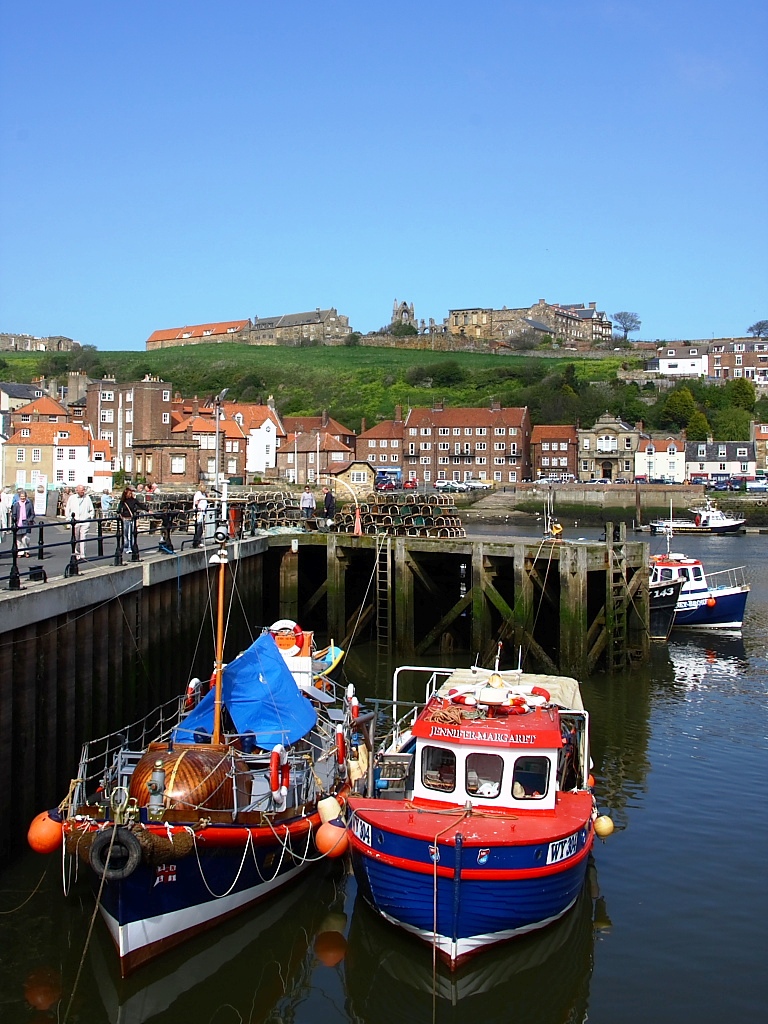A TRAVEL NEWS ARTICLE ABOUT THE UNITED KINGDOM
'JET BLACK & BEAUTIFUL'
Jet-setting took on a different meaning, when Anna Hyman and a friend headed off for Whitby in North Yorkshire.
Jet fascinates me, as indeed it did the Bronze Age, Roman and Viking craftsmen, to say nothing of the more recent Victorians. Like amber it is a valued organic fossil; but that’s not why I am drawn to it – it is its perfect, intense blackness and lustrous shine that lures me.

A fine example of jet jewellery
A piece of jet began its life many millions of years ago, when an Araucaria tree (similar to a monkey-puzzle) fell into a river and was washed out to sea where it became waterlogged and sank. As it lay on that shallow sea floor, layers of mud joined it, weighing it down and compressing it into the fossilised seams that we recognise today as jet. One of the best places to buy jet is Whitby in North Yorkshire, where seams of it can still be found.
Which was why, when a friend suggested a week’s holiday in Yorkshire, I thought that somewhere close to Whitby might be rather nice. As Barry is a serious foodie and had heard that there were one or two really good restaurants in the area, to say nothing of the Magpie Café in Whitby, famous for its fish and chips, there was no argument.
We stayed in an excellent self-catering cottage at Sandsend on the Raithwaite Hall Estate, conveniently close to Whitby, so were parked up and exploring bright and early in the morning. As I knew he would be, Barry was fascinated by the busy harbour at the mouth of the River Esk that helps to make it such an interesting town. It’s the sort of town I like – a historic working town where real people live and work rather than a chocolate-box pretty kind of tourist haunt.

Whitby Abbey
Possibly a settlement has been there for centuries because records show that round about 656 one of the Northumbrian kings founded a monastery there. The monastery was later to play a significant role in our history, when in 664 the Synod of Whitby established the Roman date for Easter over the existing Celtic one. However, Whitby remained a small fishing port right through the 16th century until it was realised that alum, so essential then for curing leather, fixing dye and for medicine, was found locally. The little port of Whitby suddenly found itself growing in prosperity from the transportation of alum and the coal used in its production. Shipbuilding followed, as did whaling when in 1753 the first whaling ship sailed to Greenland. Tourism also began to play a role in the town’s prosperity, aided by the coming of the railway in 1839.

Whitby Harbour
Whitby’s relationship with the sea is evident from the number of fishing boats moored in the harbour and the excited gulls screeching and searching for fishy scraps. The local restaurants specialise in fish, bought fresh that morning – certainly there are fish and chip outlets every few yards, or so it seems. But it was the Magpie we headed for. Even at noon there was a queue for this famous establishment, rated so highly by chef Rick Stein, but we said we didn’t mind sharing a table so Barry and I fairly quickly found ourselves seated and admiring overflowing platefuls of haddock and chips. The couple we were seated with had been there before and were wiser – asking for small portions. We didn’t eat again that day!
In an effort to walk off our generous and good value lunch, we walked up East Street in search of jet. Sadly, some of the small antique shops that used to line the street were no longer in existence, but we pottered in and out of shops and visited the tiny jet museum at the end of the street. We were only distracted from our quest by me remembering that close by was an excellent fishmonger who smoked his own kippers.
Barry, by now, was as determined as I to buy some jet. He struck lucky and bought a very elegant pair of silver and jet cufflinks. Wearing jet became very much the vogue following the death of Queen Victoria’s beloved husband Albert when the court was in mourning. However, whilst there were plenty of modern pieces, my search for Victorian earrings came to nought.

Whitby's Whale-bone arch in Winter
I had planned on climbing the 199 steps up to the Parish Church of St Mary and its churchyard,that partly inspired Bram Stoker to write his famous novel Dracula, and then to the ruined Abbey, where the 664 Synod had taken place, but arthritic hips made me change my mind so we drove up to inspect the ruins perched high on the East Cliff. We also drove over to the West Cliff to see the whalebone arch. The original whalebone can be seen at the Whitby Archives Heritage Centre. The Norwegians, I understand, presented the one we see today to the town in 1963. Also on the West Cliff is a statue of Captain James Cook, who was an apprentice in the town before making his epic voyages.
During our short stay our car took us across the beautiful moors, stopping off at picturesque small towns and villages, up the coast to Saltburn-by-the-Sea and down the coast to Flamborough Head – pausing on the clifftop to watch the colonies of nesting, screeching birds. On one of our sorties we called in at chocolate-box-pretty Robin Hood’s Bay where, in a small antique shop, I found – not Victorian jet earrings - but a lustrous, intensely black Edwardian jet brooch.
You may also like to read

UNITED KINGDOM - THE DREAMING SPIRES OF OXFORD
Tour-smart shows you the delights of taking a weekend break amongst the dreaming spires of Oxford.

UNITED KINGDOM - CORNWALL AND THE EDEN PROJECT
Tour-smart introduces you to the gardening delights of the Eden Project with its famous Biomes.


Comments